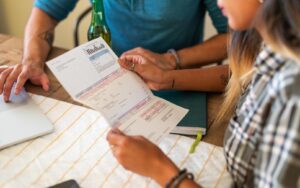It can be frustrating when your debt is climbing each month and no matter how much you try to pay it down, the high-interest fees seem to keep you from ever getting ahead. If you’ve found yourself in debt and are beginning to feel like you’re slipping deeper and deeper in, a debt reduction plan may be the salvation you’re looking for.
To pay all your debt down, a debt reduction plan can help you prioritize, set a plan of attack, and stay on track while you make progress.
How to create a debt reduction plan
Creating a debt reduction plan may help you manage your debt better. Left without a plan, it’s harder to stay on track and you could see the balances on your debt increase from fees and compounding interest.
With a debt reduction plan in place, it’s easier to keep track of your debt and your progress. You’ll see the clear success of your plan in action. Here are 4 steps to creating a debt reduction plan.
1. Audit your expenses
Something to keep in mind when you’re auditing yourself: Don’t beat yourself up. It’s not about what you’ve done or what circumstances have gotten you here. It’s about figuring out what to do now that you’re here. So, let’s do that.
Your first step is to look at everything you’re spending money on. By auditing your expenses, you’ll be able to see where your money is going. What portion of your income goes toward daily spending, monthly bills, and debt?
To audit your expenses, there are several methods you could use. You can use a computer spreadsheet to list your bills and monthly payments. You can break out the legal pad and write out your expenses. Or you may choose to track your spending automatically with the Money Manager tool at Best Egg Financial Health. No matter which method you choose, this will allow you to keep tabs on how your money is being spent and help you decide what costs you could potentially cut out ASAP.
2. Audit your debts
After creating a list of expenses, separate your list of debts. With this list in hand, you can now start to understand how much of your income is going toward your debt. This is known as your debt-to-income (DTI) ratio. Knowing your DTI ratio will help you see the big picture and understand what options you might have available to reduce your debt.
Then, take this list of debts and mark how much you’re paying toward them each month. Are you making the minimums, more than the minimums? Also, list out what your interest rates or APRs are for each.
It’s also helpful to know what kind of debts you have. Some of the debts to consider in your debt reduction plan include:
- Credit card balances
- Personal loans
- Student loans
- Medical debt
- Auto loans
This part of your debt audit can help you determine which ones should be paid off first.
3. Create a plan to pay down debt each month
Now that you have a bird’s eye view of your finances and the details of your debts, it’s time to set your goals.
What debts do you want to pay down first? How much of your monthly income can you contribute to paying these debts down, on top of the minimums you’re making now? Which debts do you feel comfortable sitting out there if you can’t pay them off right away? Your debt reduction plan should help you answer these questions.
How do you figure out your priorities? There are several methods out there, such as the debt snowball and debt avalanche methods, that can help you pay down debt on your own. The Debt Manager tool at Best Egg Financial Health will analyze your current debt and automatically sort them by debts with the highest interest to show you ways to get out of debt sooner and for less money.
It’s also important to consider all the options you have available. Some of the common ways other people have paid their debt down include:
- Part-time work or increased income
- Cutting out extra monthly spending
- Negotiated interest rates
- A debt consolidation loan
4. Consider debt consolidation as an option in your debt reduction plan
A debt consolidation loan is an easy fit for a debt reduction plan. Here’s why: With a fixed-rate personal loan, you could have a single monthly payment to keep track of, and the interest rate on the loan could be lower than the interest rates on your existing debt. Debt consolidation is a great option for someone who wants to simplify their debt payments and reduce their interest.
Why a debt reduction plan is important
When you have your plan in place, you’re more likely to be successful. With an approach that is achievable and realistic for you and your finances, your debt reduction plan could help you on your way to paying down debt.
Think about your debt reduction plan like any project in your life or career. How do you set your mind to a goal and achieve it? Set a daily reminder, keep a notebook, create a spreadsheet, have a complex system of sticky notes, maybe even build a support group of trusted friends—it doesn’t matter how you plan and keep track of your goals. Just keep track and check in with yourself often.
And by the way, it’s okay if you don’t reach your monthly goals now and then. Continue to keep yourself accountable and adjust. Even with the perfect debt reduction plan, life still happens. Take it in stride and remind yourself of the hard work you’re doing right now to reduce your debt.
This article is for educational purposes only and is not intended to provide financial, tax or legal advice. You should consult a professional for specific advice. Best Egg is not responsible for the information contained in third-party sites cited or hyperlinked in this article. Best Egg is not responsible for, and does not provide or endorse third party products, services or other third-party content.












